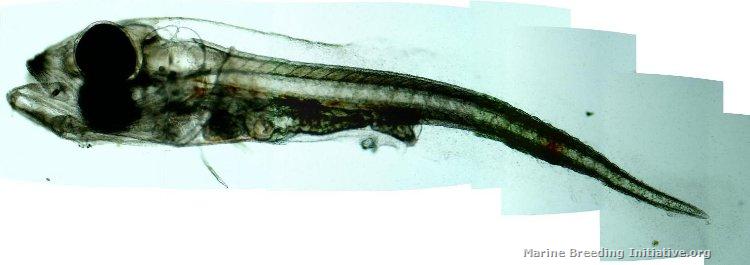Time for a brief update. This is day 5 for this batch of larvae, and they are still going strong! For these guys, rotifers + RotiGreen seems to really rock! Copepods, schmopepods (did I really just say that?). I will be giving them some copepods in the near future, but will stick with rotifers as their main diet for now.
I suspect that the problems I had with the earlier batches were due to pH swings caused by the high pH of the live phyto, but I'm just guessing. I've fiddled with too many variables to really know exactly what has made the difference.
I sacrificed one to the microscope gods yesterday. Comparing the un-resized images of younger larvae I took earlier, they really aren't growing that much in length right now, as much as they are plumping up. Here is a stiched image of one at 84 hours:

I've basically been dripping in about 20-25 drops of RotiGreen Omega + the same amount of a stock ClorAm-X solution (12 tsp. per liter) diluted in appx. 500 ml of new, aged, half-strength salt water about twice a day. The rotifer density is staying around 23-30 per ml, and I've not had to add very many rotifers. It seems that the rotifers are growing in the BRT at a rate that more or less makes up for the rate at which they are being eaten. I have added a few rotifers about every other day, but not many. The half-strength salt water I'm dripping in is making up for evaporation, keeping the SG at 1.026. I'm watching the pH, and if it drops below 7.2, then I add about 5 drops of the Alkalinity part of B-Ionic 2-part buffer to the next feeding drip, and that slowly brings the pH back up to about 7.3. Whenever I drip stuff in, I make sure to keep the rate below 1 drop per second, and to drip into the bubbles from the air stone. The seed flat heaters I have under the BRT are keeping it between 78 and 79F, with no heater in the tub to cause any trouble.
The parents' schedules is all wonky. I came home on Monday the 16th to find that she had laid eggs right by the divider, only 6 days after the last spawn. She kept looking at the egg mass over and over again, almost like she was pointing it out to me. The male was also at the divider, and all excited. I turkey basted the egg mass and gave it to the male, to see what he would do. He immediately ate them. Now I don't know what to do about their spawning schedule. I'll have to just keep an eye on them, and probably let them have "play dates" daily to see what transpires.